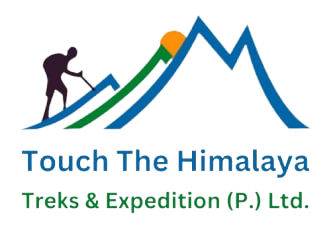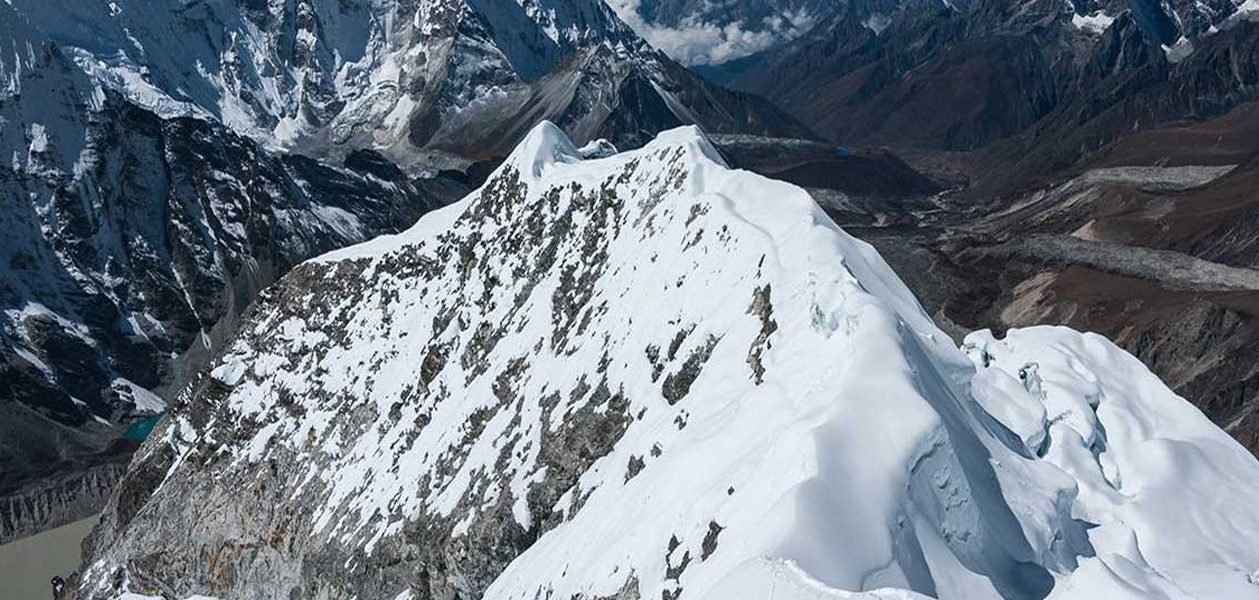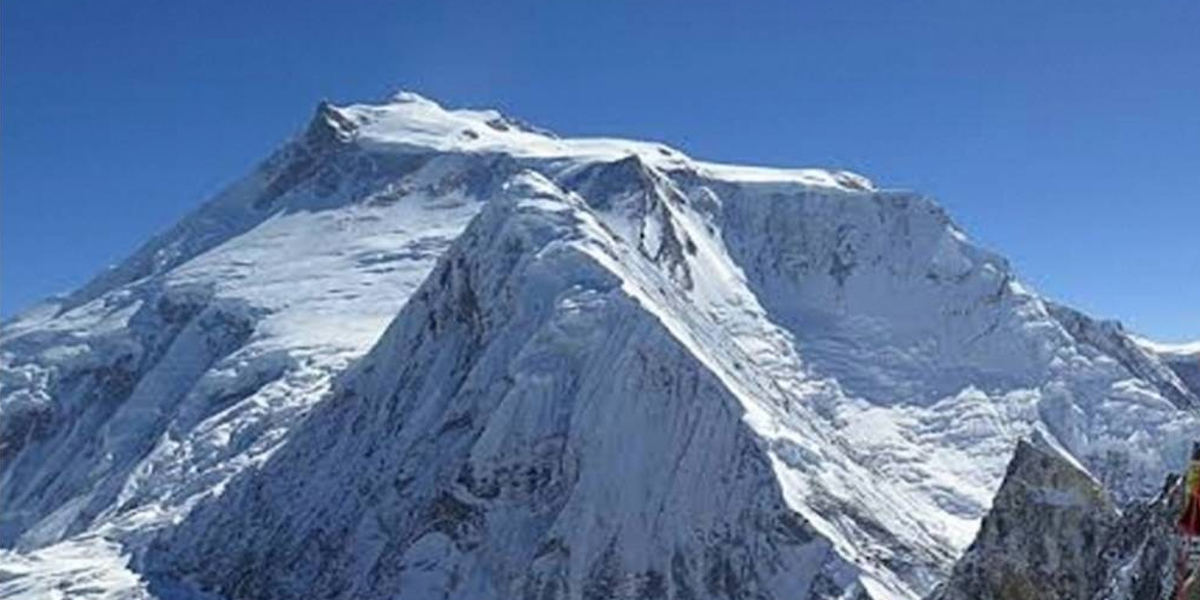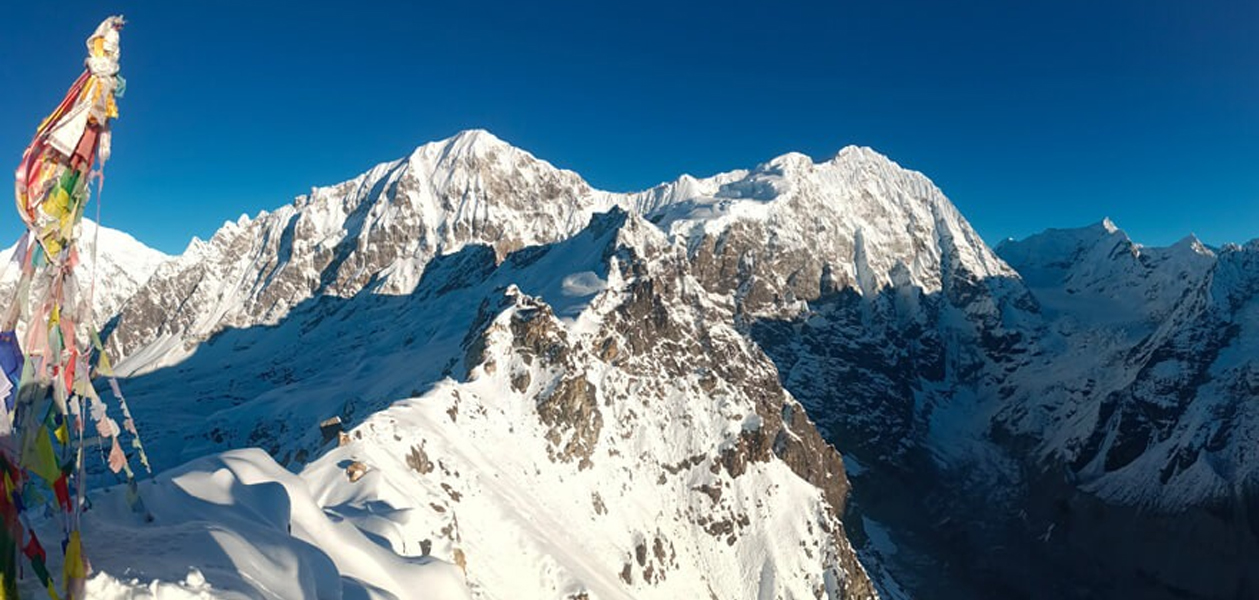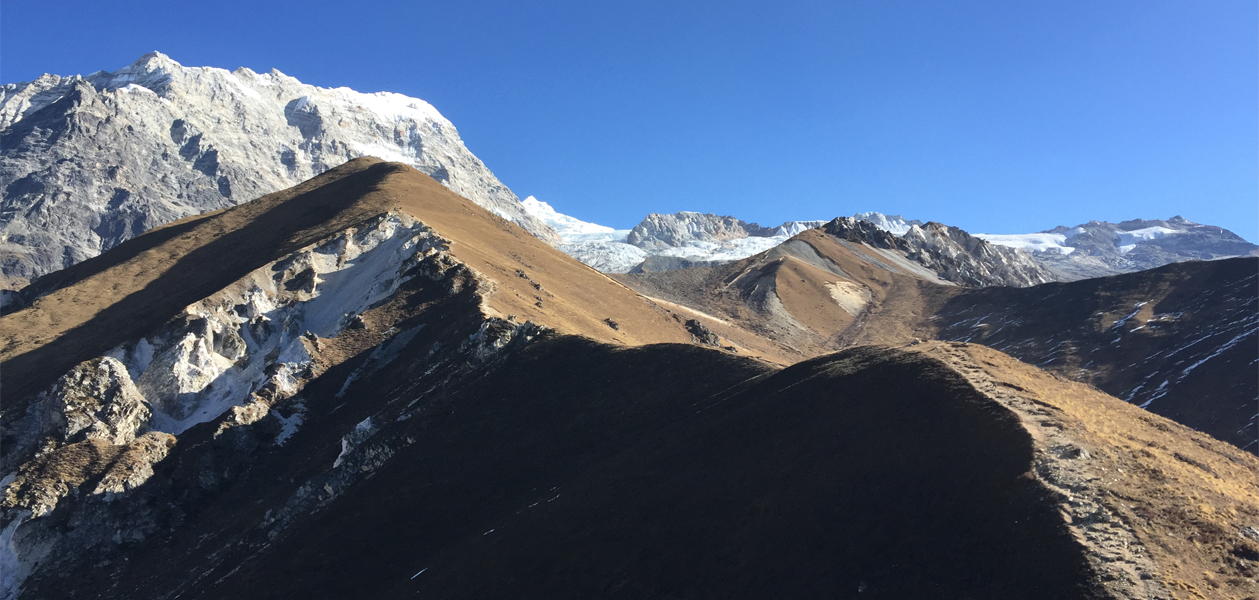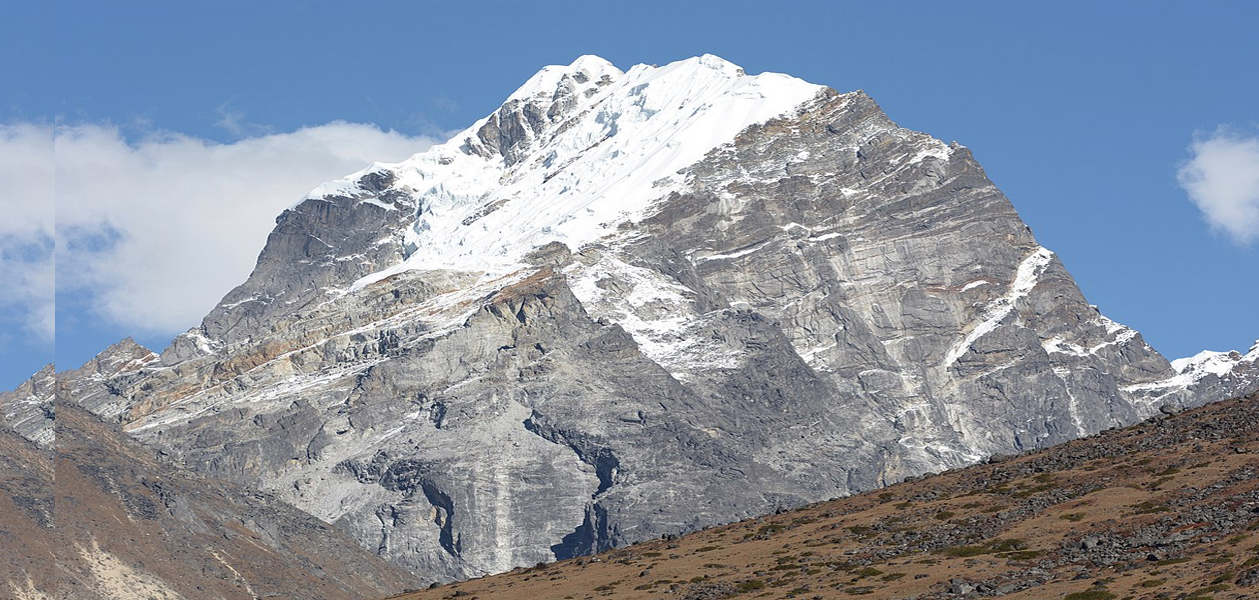Mera Peak Climbing - 18 Days
Best Selling Peak Climbing-
Duration
18 Days
-
Activity
Climbing / Expedition
-
DifficultyChallenging Trek
These treks are the most challenging and require a high level of physical fitness and mountaineering skills. The altitude may go up to 6,000 meters or more, and the terrain can be extremely rugged and steep, with challenging passes and technical sections. These treks often involve mountaineering and require special equipment and permits. Examples of difficult treks in Nepal are the Everest Three Passes Trek, Makalu Base Camp Trek, and the Kanchenjunga Base Camp Trek.
-
Max. Altitude
6476 m
-
Starts
Kathmandu
-
Ends
Kathmandu
-
Group Size
Minimum: 2 pax
-
Best Season
March-May/Sept-Dec
PRICE PER PERSON
- 1 PAX US$2366
- 2 PAX US$2027
- 3 PAX US$2008
- 4 PAX US$1958
- 5-10 PAX US$1933
- 11-20 PAX US$1883
- Highlights
- Itinerary
- What Included / Excluded
- Dates & Availability
- Additional Information
TRIP HIGHLIGHTS
- Best Selling Peak Climbing
- Mind-blowing scene from the summit.
- One of the best peaks in Nepal that can be conquered.
- The feeling of accomplishment after reaching the top.
Climbing Mera Peak Overview

Experience the thrill of climbing Mera Peak, Nepal’s highest trekking peak at 6,476 meters, which offers a once-in-a-lifetime challenge for aspiring climbers. For those looking for an amazing experience, conquering Mera Peak climbing is a dream come true because of its difficult terrain and breathtaking views. This complete guide will provide you with all the knowledge and professional advice you need to guarantee a safe, organized, and thrilling Mera Peak climbing.
Imagine yourself at the top of Mera Peak, looking down at a beautiful scene of snow-capped huge mountains.
Choosing the best time to climb Mera Peak is essential to a successful and pleasurable journey. The peak seasons for ascending this Nepalese giant are typically spring (March to May) and autumn (September to November), when the weather conditions are relatively stable and favorable for climbing. During these periods, you can expect clear skies, moderate temperatures, and minimal precipitation, enhancing your chances of reaching the summit safely.
Table of Contents
Planning Your Mera Peak Climbing
Which is the Best Time to Climb Mera Peak?
Choosing the best time to climb Mera Peak is essential to a successful and pleasurable journey. The weather of the Himalayas is harsh and very unpredictable so picking the right season is a must before attempting to climb the peak. The best times to climb the Mera Peak of Nepal are usually in the spring and fall when the weather is more stable and favorable for climbing. During the monsoon or winter, the rain and snow cause major disturbances such as avalanches in the Himalayas.
There are two separate climbing seasons at Mera Peak Climbing, and each has its benefits:
Spring (March-May): Spring is the best time to climb Mera Peak. At this time, you can enjoy pleasant weather with a clear atmosphere and minimal snowfall. Afternoon clouds can occasionally build, but visibility is generally good.
Autumn (September-November): Another best time to climb Mera Peak is Autumn. At that time, experience a crystal-clear atmosphere and stable temperatures, perfect for taking in the stunning Himalayan views. Be well prepared for colder nights at higher altitudes.


Dividing Expenses: Budgeting for Your Mera Peak Climbing Cost
Although Mera Peak climbing can be costly, careful planning and budgeting will help you keep expenditures under control and make this a pocket-friendly expedition. Here’s a breakdown of the typical expenses you can expect:
Permits and Documentation: Mera Peak Climbing Permit, TIMS card, Sagarmatha National Park entry fee.
Guides and Porters: Hiring experienced guides and porters is highly recommended for safety and logistical support.
Equipment and Gear: High-quality climbing gear, including crampons, ice axes, ropes, and appropriate clothing layers.
Transportation: Flights to and from Lukla, as well as local transportation to and from the airport.
Accommodation and Meals: Teahouse stays and meals during the trek and climb.
Insurance: Complete travel and climbing insurance for emergencies.
Note:
The cost of your Mera Peak Climbing can vary depending on several factors, including:
Trip Duration: Longer expeditions with more acclimatization days will naturally cost more.
Group Size: Smaller, personalized groups tend to be pricier than larger ones.
Chosen Operator: Different operators offer varying levels of service and amenities, depending on your budget.
Expect a cost range of approximately US$ 1,883 per person. Remember, this is an investment in your safety and an unforgettable experience.
How Difficult is Climbing Mera Peak?
While Mera Peak is not a technical climb requiring advanced rope skills, it’s a high-altitude challenge (6,476 meters) demanding good physical fitness and mental preparation. Proper acclimatization is crucial for a safe and enjoyable experience. Proper experience as well as dependable guides and porters are a must for climbing this peak. It is recommended that you have prior experience trekking at least up to 4000 meters before attempting this peak climb.
Securing Your Path: Obtaining Mera Peak Climbing Permits
Obtaining a Mera Peak Climbing Permit is mandatory for any expedition. The primary permit required is the Mera Peak Climbing Permit, which can be acquired from the Nepal Mountaineering Association (NMA) or through a reputable trekking agency. Additionally, you’ll need a Trekkers’ Information Management System (TIMS) card and a Sagarmatha National Park entry permit, as the peak is located within the boundaries of this protected area. Fees typically cover essential services like park entrance and waste management.
Mera Peak Climbing Routes:
The standard Mera Peak climbing route offers stunning scenery and well-established trails. Key milestones include picture-perfect villages like Chhukung and Khare, and camps like BaseCamp and High Camp. For an even more adventurous experience, consider including the challenging Amphu Laptsa Pass trek, adding an extra dimension to your Mera Peak adventure. Please consult with your guide before attempting anything challenging to make sure your guide is familiar with the path.
Accessing Mera Peak involves taking one of several trekking routes, each offering its own unique challenges and scenic rewards. The most popular routes include:
Hinku Valley Route: This classic approach starts from Lukla and takes you through the beautiful Hinku Valley, passing by traditional Sherpa villages, glaciers, and breathtaking mountain views.
Zatrwa La Pass Route: A slightly more challenging option, this route begins from Lukla and traverses the Zatrwa La Pass, offering stunning views of the Khumbu region and the iconic Mount Everest.
Amphu Laptsa Pass Trekking: For the ultimate adventure, combine your Mera Peak climb with the Amphu Laptsa Pass trekking, an off-the-beaten-path experience that takes you through remote villages and untouched landscapes.
Everything You Need to Climb Mera Peak.
Proper equipment is vital for a successful climb. Proper gear and equipment are vital for a successful and safe Mera Peak climbing adventure. Here are some essential items you’ll need:
- High-quality backpack and duffel bags for carrying gear
- Warm and insulated climbing boots with compatible crampons
- Layered clothing system (base layers, insulating mid-layers, and waterproof outer layers)
- Sleeping bag rated for extreme cold temperatures
- Trekking poles for stability and support
- Headlamp and backup batteries
- Sun protection (sunglasses, sunscreen, lip balm)
- First aid kit and personal medications
- Hydration system and water purification tablets
- Climbing gear (harness, carabiners, ascenders, descenders, etc.)
- Tents and camping equipment (optional, based on your accommodation preferences)
- Personal items like essential toiletries.
Consider renting specialized equipment like high-altitude boots from your chosen operator. This ensures top-level quality and functionality without the additional cost of purchasing gear you might only use once.

Safety First: Mera Peak Climbing Safety Measures and Risk Management
Climbing Mera Peak is a demanding endeavor, and prioritizing safety should be your utmost concern. Unlike trekking this expedition will require you to live in harsh weather conditions for a prolonged period so proper preparation before departure is an utmost requirement. Here are some essential precautions and risk management strategies to consider:
- Hire experienced and reputable guides and porters who are familiar with the terrain and can provide expert guidance
- Closely monitor weather forecasts and be prepared to adjust your plans accordingly
- Strictly follow acclimatization protocols to minimize the risk of altitude sickness
- Carry emergency communication devices (satellite phones, personal locator beacons) and have evacuation plans in place
- Obtain complete travel and climbing insurance to cover emergencies and medical expenses
- Familiarize yourself with the signs and symptoms of altitude sickness and take immediate action if necessary.
Mera Peak Climbing Training
Building a strong physical foundation is key to conquering Mera Peak. Focus on aerobic and strength training routines several months before your climb. Activities like hiking with a weighted backpack, running, and interval training can significantly improve your performance. Also, the altitude you will be climbing is well above normal so chances of altitude sickness are high. To tackle this make sure you have gathered enough experience of trekking above 4000 meters. Consulting a professional trainer can provide personalized guidance and ensure your training program is optimal for the challenges of Mera Peak.
Choosing a Mera Peak Climbing Agency
Climbing Mera Peak is no small feat so choosing the right agency can make all the difference. Here’s why choosing a reputable operator is crucial:
Experienced Guides: Qualified, well-trained, seasoned, and certified guides with a proven safety record ensure your well-being throughout the climb.
Proper Logistics: A seamless experience requires meticulous planning and logistics management. Your chosen operator handle should be able to handle everything from permits to transportation and accommodation.
Safety Measures: A reputable agency prioritizes your safety with high-quality equipment, comprehensive medical support systems, best guides, and emergency preparedness measures.
Why Climb Mera Peak with Touch The Himalaya?
Incomparable Experience
Touch The Himalaya boasts a wealth of experience leading the journey on Mera Peak. Our team of qualified and certified guides has a proven safety record, ensuring you have the expertise and support you need every step of the way.
Personalized Approach
At Touch The Himalaya, we believe in a personalized approach. We offer small group sizes, allowing our guides to provide tailored attention and support throughout the climb. Better adaptation guidance and a more varied experience are promoted by this. Also, we offer customizable itineraries according to your needs.
Safety First Mentality
Your safety is our top priority. We utilize high-quality, well-maintained equipment on all our expeditions. Our guides are fully trained and licensed by the government to provide any support that you may require during your expedition. Additionally, we have complete medical support systems in place and prioritize emergency preparedness measures such as evacuation helicopters and a team of medical experts waiting at the helipad to provide you assistance.
Unforgettable Adventure
Climbing Mera Peak with Touch The Himalaya goes beyond the physical challenge. We curate an unforgettable adventure that incorporates the rich cultural heritage of the region. Experience breathtaking scenery, stay in comfortable and well-maintained camps, and potentially interact with the warm and welcoming Sherpa people. Our guides are seasoned and can provide you with insights about the local culture, tradition, and architecture.
Finding the Perfect Climbing Partner
Choosing the right climbing company is a vital step towards your Mera Peak summit success. To help you find the perfect partner for your adventure, consider researching companies like Touch The Himalaya with a strong reputation for safety and exceptional service. We have been providing trekking, hiking, tours, and expeditions for over a decade.
Conclusion:
Climbing Mera Peak is a once-in-a-lifetime adventure that promises to challenge you physically and mentally while rewarding you with breathtaking scenery and an exceptional sense of accomplishment. By following this complete guide and paying attention to the expert advice, you’ll be well-equipped to conquer this Himalayan giant safely and create lasting memories. So, gear up, train hard, and get ready to free your climbing spirit on the delightful slopes of Mera Peak!
Itinerary
Welcome at Tribhuvan International Airport, then transfer to your hotel.
Trek preparation and introduce with trekking staffs
Kathmandu to Lukla (a 45-minute flight) and uphill trek to Chhuthang (4-5 hours)
Trek from Chhuthang to Tuli Kharka via the Zatrawala Pass (5–6 hours)
Trek from Tuli Kharka to Kothe (6-7 hours)
Trek from Kothe to Thangnak (4–5 hours)
From Thangnak, get to Khare (5–6 hours)
Acclimatization day at Khare
Trek from Khare to Base camp (3–4 hours)
Khare to Mera High Camp (4–5 hours)
In the case of bad weather, set aside a day.
Climb to the top of Mera Peak [6,476 m/21,246 ft] and then descend to Khare.
Trek back from Khare to Kothe (5–6 hours)
Trek from Kothe to Tuli Kharka (5–6 hours)
Trekking through the Zatrawala Pass from Tuli Kharka to Lukla (6-7 hours)
Lukla to Kathmandu flight, then transfer to hotel
Free Day in Kathmandu for Leisure
International flight from Kathmandu
Itinerary Note:
This itinerary is just the guide line, it can be changed (longer or shorter) as per our client's wishes, fitness, ground reality and weather condition. If you're not satisfied or have an alternative plan please feel free to discuss it with us By Clicking :- ASK QUESTION or COSTOMIZE YOUR TRIP.What's Included / Excluded
Cost Incluldes
- Airport pick up and drop off by Car, jeep, Hiace or Bus. Depends on the number of arrives.
- Complimentary welcome or farewell dinner according to the suitability of our client’s time.
- Beginning two nights stay on arrival in Kathmandu in tourist standard hotel with breakfast included (twin share basis)
- Internal transport and flight within Nepal as per the itinerary
- All necessary trekking and area permit & fees, (National Park area special permit and TIMs cards).
- Three meals a day during the trek (If of required, we provide meal during the trekking)
- All accommodation during trek (If of required we arrange all accommodation)
- An experienced, English-speaking, government-licensed, first aid trained trekking guide and assistant guide (10 trekkers: 1 assistant guide)
- Expert local porters (2 trekkers: 1 porter)
- Duffel bag, (to be returned after trip completion), complementary trekking maps. If needed down jacket and sleeping bag will be provided in rent.
- Staff costs including their salary, insurance, Equipment, transport, food and accommodations
- Rescue arrangements if necessary.
- Basic First-aid kit (carried by trekking guide)
- All government and local taxes for Trekking, Agency service charge and government tax/vat.
- Achievement Certificate
Cost Excludes
- International airfare and Nepal visa fee.
- Lunch and Dinner in Kathmandu
- Extra night accommodation in Kathmandu because of early arrival, late departure, early return from mountain (due to any reason) than in the scheduled itinerary
- Personal insurance which covers medical, emergency evacuation, loss or theft of property.
- Personal gears and equipment.
- Personal expenses such as laundry, hot showers, battery charging, Wifi, etc
- Entry fees and costs in sightseeing (temples, monasteries, etc)
- Tips and gratitude provided to guide and porter.
Fixed Departure
Can't find trip as your Schedule Date?
- Above mentioned departure dates “AVILABLE”‘ means these dates are currently open for bookings for the particular Trek. If the mentioned dates are not suitable with your preferred date, you can make your own private trip by clicking the box billow in the bottom.
- A date “GUARANTEED” means that we give guarantees that the costumers will be able to start theirs trek on the specified date, regardless of whether the seats are fully booked or not.
- “LIMITED”‘ Status refers to a type of seats booking for the trek, that has been certain seats available to book
- In the status, “CLOSED” means that the Trekkers seats are fully booked and there are no more seats available for new booking. Trekkers may be put on a waitlist for a chance to get a seat if there are cancellations unless your are requested to plan your own private trip by clicking the box billow in the bottom.
Additional Information
All the trip grading can be view here.
If you have any confusion for booking process please visit our booking process.
